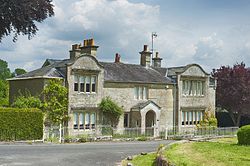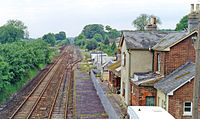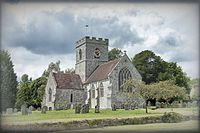Dinton, Wiltshire
| Dinton | |
| Wiltshire | |
|---|---|
 Dinton Lodge | |
| Location | |
| Grid reference: | SU014315 |
| Location: | 51°4’59"N, 1°58’52"W |
| Data | |
| Population: | 696 (2011) |
| Post town: | Salisbury |
| Postcode: | SP3 |
| Dialling code: | 01722 |
| Local Government | |
| Council: | Wiltshire |
| Parliamentary constituency: |
South West Wiltshire |
| Website: | Parish |
Dinton is a little village in the south of Wiltshire, in the valley of the River Nadder. It is tobe found beside the B3089 road about eight miles west of Salisbury.
The parish population was 696 at the 2011 census, estimated at 733 in 2019. The wider civil parish includes the village of Baverstock, about a mile east of Dinton village.
Contents
History
The northern bounds of the parish follow a prehistoric line known as Grim's Ditch, through downland overlooking the Wylye valley further north.[1][2] Hanging Langford Camp, an Iron Age settlement, is just beyond the parish boundary.[3] The hillfort known as Wick Ball Camp lies near the western boundary of the parish, partly within Dinton Park.[4]
A Roman road from the Mendip lead mines to Old Sarum passed east–west, just south of the ditch.[1]
The Domesday Book of 1086 records a settlement of 37 households at Dinton, held by Shaftesbury Abbey.[5]
After the Dissolution of the Monasteries in 1540, much of Dinton's land was acquired by the Earls of Pembroke. Later other land was purchased by the Wyndham family, which created Dinton Park. All Pembroke and Wyndham land was sold in the 20th century.[6]
Dinton had a school from an early date, with some 80 children attending in 1818.[1] A National School was built in 1872 and took children of all ages until 1935, when those over 11 transferred to Wilton. The school became a Church of England voluntary controlled school in 1945.[7]
The Salisbury and Yeovil Railway was built across the parish in 1859, passing to the south of Dinton and Baverstock. Dinton station was south-west of the village on a lane towards Fovant. The station closed in 1966.[8] A branch called the Fovant Military Railway, two and a half miles in length, ran south from near the station to the military camps around Fovant; it was opened in 1915 and closed in 1920.[9]
In 1934 the parish was extended eastwards to absorb the ancient parish of Baverstock.[1] Before, during and after the Second World War, the area was used for storing military equipment and ammunition. Some of these premises were outposts of RAF Chilmark.[10]
Churches
St Mary, Dinton
The Church of England parish church of St Mary the Virgin, begun in the late 12th century, is a Grade I listed building. The north doorway survives from the earliest work, while the rest of the church is largely from the 13th and 14th centuries. Restoration by William Butterfield in 1873–1875 included adding a south vestry and north porch.[11] The tower has six bells, one from the 14th century and two from the 16th.[12]
Until the Dissolution of the Monasteries, Dinton was a prebend of Shaftesbury Abbey. St Edward's at Teffont Magna was a chapelry of Dinton until 1922.[1] Today the church is part of the Nadder Valley team ministry, which also covers Baverstock and Teffont.[13]
St Editha, Baverstock
The church at Baverstock, dedicated to Edith of Wilton, is from the 14th–15th centuries, with restoration in 1880–1893 by Butterfield. It is Grade II* listed.[14]
About thee village
Three listed houses are now owned by the National Trust.
Hyde's House, near Dinton's church, is a Grade I listed former rectory, an early 18th-century rebuilding of an earlier house. Together with Philipps House and Dinton Park, it was given to the National Trust by Bertram Philips in 1943.[15]
Philipps House, formerly Dinton House, was built in 1816 by William IV Wyndham (1769–1841) to designs by Sir Jeffry Wyatville, replacing a 17th-century house. The house stands in formal gardens and parkland known as Dinton Park. In 1916 the estate was bought by Bertram Philipps, who renamed the house after himself.[16][17]
Little Clarendon, also Grade II* listed, is a late 17th-century former farmhouse. The house was restored in the early 20th century by George Herbert Engleheart (died 1936), a noted breeder of daffodils. His widow gave the house to the National Trust in 1940.[1][6][18]
About the village
The parish has local services, including two public houses and a village hall.
The railway remains open as part of the London Waterloo to Exeter line; the nearest station is Tisbury. The village school continues on the same site as Dinton C of E Primary School.
The Monarch's Way long-distance walking route crosses the parish north of Dinton, leaving by way of Grovely Wood.
Outside links
| ("Wikimedia Commons" has material about Dinton, Wiltshire) |
- Dinton
- Dinton Village Hall
- Dinton Church of England Voluntary Controlled Primary School
- Philipps House and Dinton Park: National Trust
References
- ↑ 1.0 1.1 1.2 1.3 1.4 1.5 A History of the County of Wiltshire - Volume 8 pp 25-34: Warminster, Westbury and Whorwellsdown Hundreds – Dinton (Victoria County History)
- ↑ National Heritage List 1005606: Grim's Ditch (Scheduled ancient monument entry)
- ↑ National Heritage List 1005602: Hanging Langford camp and Church-end Ring (Scheduled ancient monument entry)
- ↑ National Heritage List 1005673: Wick Ball Camp, The Common (Scheduled ancient monument entry)
- ↑ Dinton, Wiltshire in the Domesday Book
- ↑ 6.0 6.1 "Dinton". Wiltshire Council. https://history.wiltshire.gov.uk/community/getcom.php?id=79.
- ↑ "Dinton Church of England VC Primary School". Wiltshire Council. https://history.wiltshire.gov.uk/community/getschool.php?id=1364.
- ↑ Oakley, Mike (2004). Wiltshire Railway Stations. Wimborne: The Dovecote Press. pp. 56–57. ISBN 1904349331.
- ↑ Fovant Military Railway: Fovant History Interest Group
- ↑ A History of the County of Wiltshire - Volume 13 pp 114-125: Parishes: Chilmark (Victoria County History)
- ↑ National Heritage List 1146120: Church of St Mary the Virgin (Grade I listing)
- ↑ "Dinton, St Mary". http://dove.cccbr.org.uk/detail.php?DoveID=DINTON%20WIL.
- ↑ "St Mary, Dinton". https://www.achurchnearyou.com/dinton/.
- ↑ National Heritage List 1283631: Church of St Edith of Wilton (Grade II* listing)
- ↑ National Heritage List 1146122: Hydes House with attached walls and gatepiers (Grade I listing)
- ↑ National Heritage List 1318756: Phillips House (Grade @ listing)
- ↑ National Heritage List 1001231: Dinton Park (Grade @ listing)
- ↑ National Heritage List 1146116: Little Clarendon (Grade II* listing)

